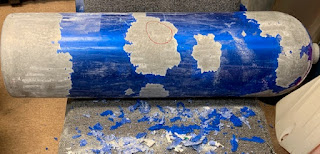Save your dive. Save yourself!
Hi fellow divers. This is the first in a series of monthly articles focused on scuba equipment maintenance, repair, and configuration. Make this a dialog by providing feedback and asking questions to be answered in future articles. We have thousands of dives among us. We become better divers by sharing our experiences, be they close calls, good tips, funny situations, or curious questions.
What do you take with you on a road trip? I take navigation software, beverages, snacks, music, a spare tire, some basic tools, blanket, and jumper cables. Divers like to eat and drink, so we're pretty good about bringing coolers and food. How about spare parts and tools to perform basic field repairs?
Our scuba gear is our life support system. It's surprising how many divers are tempted to dive with a leaking SPG or primary second stage regulator because they've spent time and money getting to their destination, be it a 30-minute drive to a local dive site, a road trip to Florida caves and reefs or North Carolina wrecks or flying to an exotic foreign destination. Let's take the smarter, safer path by customizing our own save-a-dive kit. You could call it a save-your-life kit.
O-rings are the most common problem...and the cheapest to fix! Sand and salt cut them, rendering them useless, allowing water in and air to escape. NEVER reuse ANY O-rings. (Would you let your mechanic reuse O-rings or gaskets on your car's engine?) We've all seen divers turn a cylinder valve O-ring around and reuse them. Does it work? Sometimes. Is it smart? Not when a new O-ring costs about 25 cents and takes seconds to install.
Here's a three-stage plan to build your save-a-dive kit. Start with a few basics, then add to it as your dive education and experience broaden your interests. Bubbles or Not Diving can help you build your kit. Looking for Christmas present ideas for your favorite divers? These components make great stocking stuffers!
The Basics
- Weather-resistant box (e.g. Pelican case, fishing tackle box)
- Mask and fin straps
- Batteries for computers, lights, cameras
- AA, AAA, CR2025, CR2032, 2302, 18650, etc.
- Mouthpiece
- Tie wraps
- Assorted O-rings:
- Cylinder valve yoke or DIN fitting, low and high pressure hoses
- Masking defogging solution
- Snorkle keeper
 |
| Scuba tool kit in a zippered case Photo: Innovative Scuba Concepts |
Smart Additions
Add these pieces to increase your preparedness. Bubbles or Not offers a handy set of tools in a zippered nylon case that includes silicone lubricant, O-rings, two wrenches with sizes 1/2", 9/16", 5/8" and 11/16" (four wrenches in two), a flathead and Phillips screwdrivers. Also consider:
- Adjustable wrench
- SAE and metric hex keys (aka Allen wrenches)
- Nylon or brass pick to remove O-rings without scratching metal surfaces
- Extra high and low pressure (HP/LP) hoses
 |
| Divers Alert Network (DAN) emergency O2 kit with demand valve regulator in waterproof case Photo: Divers Alert Network |
Expanding your dive locker
- Extra slate
- Dive float and flag
- LP and HP 1st stage regulator port plugs (store in a small medicine bottle)
- LED light stick for night dives
- Exposure suit maintenance items
- Wetsuit shampoo
- Wetsuit hanger
- Drysuit hanger with wide shoulders to keep the suit's shape
- Drysuit zipper wax
- Drysuit talc to keep the latex seals from drying out
- BC hanger: aids drying and keeping your BC's shape
- Bootie hangers: facilitates drying, eliminating that funky bootie smell
- Emergency oxygen kit in a sealed case




I second the not reusing O rings. You may come to regret being penny wise but pound foolish. You young folks may need to Google that expression.
ReplyDeleteHey paw, look what I did. The other side of the furnace filter looked clean, so I just turned it around and put it back in!
Dave
Great article, Fred! O-rings are just too cheap and too important to skimp on. I'd add extra batteries for lights and 'puters, extra straps for your fins and a spare mask. Nothing worse than pulling on your fin and having the strap break. Keep the articles coming old friend
ReplyDeleteTerrific additions, Nate. Next post on servicing regulators will be out this week!
Delete